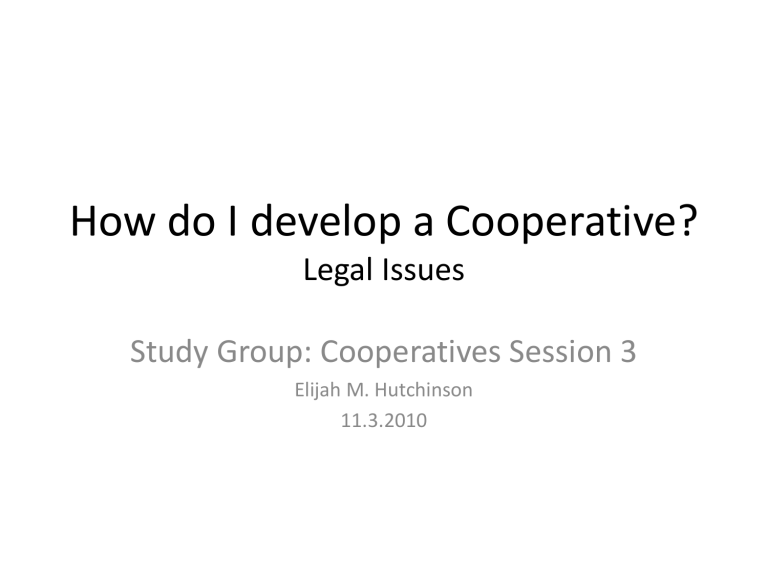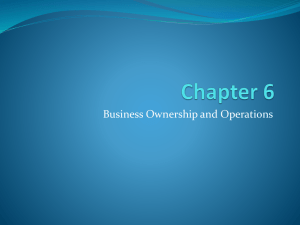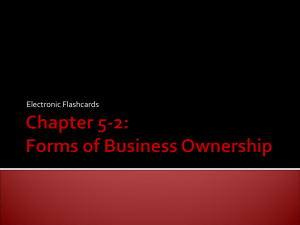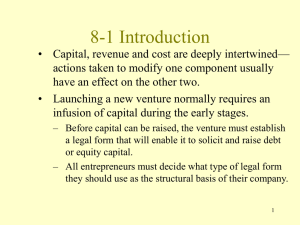Why Choose a Cooperative as a Business Model?

How do I develop a Cooperative?
Legal Issues
Study Group: Cooperatives Session 3
Elijah M. Hutchinson
11.3.2010
Get some things out of the way…
• There is no single “accepted” legal or organizational structure for organizing worker-owned cooperatives
• Basic Coop Definition
– 1. Owned and controlled by its “patrons” (i.e. customers, producers, or workers)
– 2. One person one vote
– 3. “Surplus” is returned to the owners on the basis of their patronage
• Note that these characteristics can be built into almost any legal structure
Considerations for Legal Structure
• Financing Sources
• Operations/Accounting
• Democratic processes
• Taxation of earnings
• Legal liability of members; corporation
• Profit distribution
• Types of permissible activities
Popular Legal Structures in US
• Cooperative (157A, Massachusetts General Laws)
• Partnership or Limited Partnership
• Limited Liability Corporation (LLC)
• L3C
• Corporation (S or C)
• Tax Exempt Corporation
• B Corp
GET A LAWYER …FROM YOUR STATE
Some History
• Massachusetts enacts first statue in United States supporting cooperative formation…in 1866!
• Massachusetts enacts first statue in United States specifically for worker-owned cooperatives in 1982
• Legislature passed “Industrial Cooperative Associations Law”, inspired by Basque cooperative model
• All states now have cooperative statues;
• Four principal parts:
– Allows corporation conversion into cooperative membership organization democratically controlled by workers
– Permits equitable allocation of earnings and loses to members based on their relative contribution of labor, not relative capital investment
– Authorizes cooperative capital structure and accounting
– Sets forth a capital allocation procurement structure consistent with Subchapter T
Cooperative Corporations
• Entitled to benefits of all corporations:
– Limited liability; perpetual existence; tax-deductible fringe benefits for employees
• Incorporated under state’s cooperative statutes:
– Able to use “cooperative” in name
– Able to issue membership instead of shares of stock
– Exemptions from or simplified procedures for registering members with
SEC and State agencies
– Payment of patronage refunds based on participation
– Possible exemption from stock permit fees required for most for-profits
– Take advantage of Subchapter T of Internal Revenue Code; avoid double taxation on profits
Mass. General Laws; Employee Cooperative
Corporations (Part I, Title XXII, Chapter 157A)
• Section 1 Short title
• Section 2 Definitions
• Section 3 Corporations organized under chapter 156D; election to be governed as employee cooperative
• Section 4 Revocation of election
• Section 5 Corporate name
• Section 6 Members; membership shares; fees; rights and responsibilities
• Section 7 Voting shares; by-laws; amendment of articles of organization
• Section 8 Net earnings or losses; apportionment, distribution and payment
• Section 9 Internal capital accounts; recall or redemption of shares; interest; collective reserve account
• Section 10 Internal capital account cooperatives
• Section 11 Conversion of membership shares and internal capital accounts upon revocation of election; consolidation or merger http://www.malegislature.gov/Laws/GeneralLaws/PartI/TitleXXII/Chapter157a
Governance
• Articles of Incorporation
– constitution or business charter
• Bylaws
– describes operations; can be general or specific
• Directors
– approve budgets, contracts, and work plans; responsible for records, elections, financial statements; procures professional help
• Managers or Officers
– Responsible for operations; legal authority to enter into contracts
• Shareholders/Workers/Members/Owners
– Vote!; amend bylaws, etc; operations
• Outside Investors
– Restricted voting rights; may have veto power
Partnership or Limited Partnership
• Automatically created when a group of people get together to run a business – no filing required
• No liability protection for partners – each partner is personally liable for any liabilities or debts of the partnership
• May be sheltered from State taxes (e.g. franchise tax)
• Pass through entity for tax purposes
• Partners are not employees
Limited Liability Corporation (LLC)
• LLCs have the limited liability of a corporation and are taxed like partnerships
(they can elect to be taxed as corporations)
• Owners (members) are not employees
• Member managed vs. manager managed
• All earnings subject to self employment tax (guaranteed payments and profits)
• Cannot have unallocated equity – all equity is allocated to member capital accounts (can create instability)
• You can't use an LLC if you need a contractors license (some States)
• Very flexible; No formalities required
• Superior with respect to outside liability protection
• Phantom income problem
L3Cs – Low-Profit, LLC - NEW
• L3Cs are LLCs specially designed to attract foundation investments – LC3s formed in
Vermont can be used in any state
• Foundations are required to distribute five percent of the value of their net assets for charitable purposes each year. To meet this requirement, foundations primarily make grants to charitable organizations. However, foundations are also permitted under the Internal Revenue Code to invest this five percent of net assets in for-profit entities that meet a three-pronged test:
– The entity must be formed primarily for charitable or educational purposes;
– No significant purpose of the entity is the production of income or the appreciation of property;
– No purpose of the entity is to conduct legislative or political activities;
– (Internal Revenue Code (IRC § 4944(c) and Treas. Reg. § 53.4944–3)
• The investment (called a Program-Related Investment or PRI) are relatively uncommon because foundations are unwilling to risk the uncertainty of having the
IRS determine that a PRI it makes does not in fact meet the statutory requirements.
• L3Cs were created in response to this problem. An L3C is identical to an LLC except that it is organized for a business purpose that satisfies and is at all times operated to satisfy each of the requirements for a PRI.
S - Corporation
• Just like a C - corporation (standard corp.) but with taxed like partnership
• Special requirements to maintain S Corp status:
– No more than 100 shareholders
– Shareholders must be individuals; citizens or legal residents
– Only one class of stock (different voting rights not considered a different class)
• Failure to meet these requirements results in automatic loss of S status
• California: 1.5% tax on entity
• Owners are employees – no self employment tax
• Phantom income problem
B Corp
• Certification system by B-Lab to support socially beneficial corporation
• Not a statutory business form; any type of business can be a B Corp
• A state (20 States) without a “constituency statute” must do what is in the best interests of the shareholders (investors) – period.
• Board cannot legally put the interests of the community, the environment, workers, or any other stakeholder group ahead of shareholders’ interests
• Commitment can expose a corporation’s board to potential liability
• http://en.wikipedia.org/wiki/B_corporation
• www.bcorporation.net
Issues
• Conflicts and Tensions; Who’s the Boss?
• Surplus Distribution; Compensation
• Deficits; Labor Surplus; Wage Loss
• Outside Investors
• Accounting and Compliance w/SEC, State Regulators
• Financing Start-up/Capital Improvements; Lending Market
• Case-Law; Other Liabilities; i.e. Taxation of Patronage Dividends
• Organize as Not-for-Profit?; i.e. 501(c)6 or 501(c)12
• Conversion of Incorporation
• What can we think of?
Speakers
• Ed DeBarbieri http://www.equaljusticeworks.org/communities/alumni/profiles
?q=node/14&pid=15245
• Jenny Kassan http://katovichlaw.com/aboutus/ourteam/jenny/
NOTE: some slides in this presentation are edited versions of larger presentation from Ms. Kassan that can be publically accessed from the weblink above
mitcooperatives.wordpress.com
• Suggested Readings; References
• Toolkits-Handbooks
• Organizational Charts and Checklists
• Supporting Organizations
• Massachusetts State Regulations
• Sample Bylaws and Articles of Incorporation
• Conference Publications
• Legal Journal Articles











